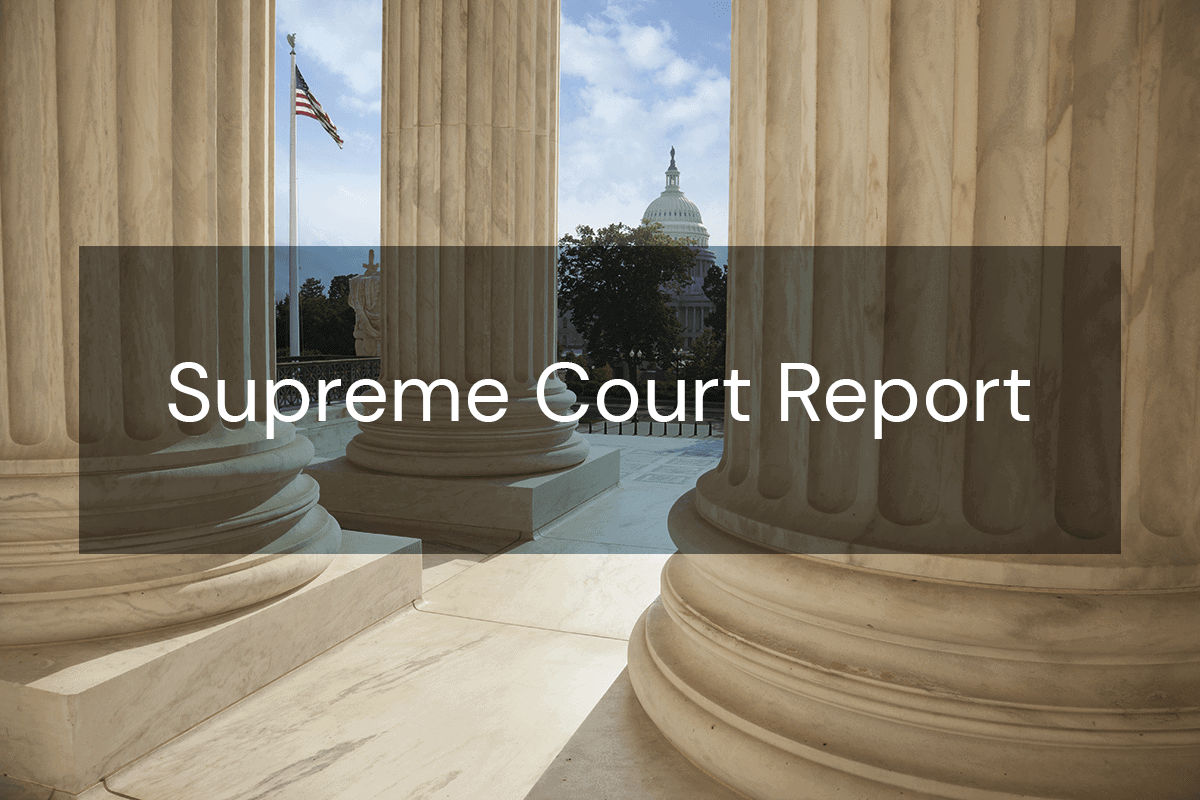-
 Director, Center for Supreme Court AdvocacyNational Association of Attorneys General
Director, Center for Supreme Court AdvocacyNational Association of Attorneys General

This Report summarizes opinions issued on June 21, 2022 (Part I); and cases granted review on that date (Part II).
Case Granted Review: United States, ex rel. Polansky v. Executive Health Resources, Inc., 21-1052
United States, ex rel. Polansky v. Executive Health Resources, Inc., 21-1052. This case addresses “[w]hether the government has authority to dismiss [a False Claims Act] suit after initially declining to proceed with the action, and what standard applies if the government has that authority.” The False Claims Act (FCA) “imposes civil liability for deceptive practices involving government funds” by targeting a person who makes false claims for payment. The FCA authorizes private parties (known as relators) to bring qui tam actions on behalf of themselves and the federal government. 31 U.S.C. §3730(b)(1). FCA complaints are filed under seal and then the government has 60 days (subject to extensions) to investigate and decide whether it wants to intervene and proceed with the action or whether it will decline to take over the action. §3730(b)(2)-(4). If the government chooses not to proceed, the relator may conduct the prosecution and the government remains a real party in interest. The government may also seek dismissal of the action under §3730(c)(2)(A): “The Government may dismiss the action notwithstanding the objections of the person initiating the action if the person has been notified by the Government of the filing of the motion and the court has provided the person with an opportunity for a hearing on the motion.”
Petitioner Jesse Polansky is a doctor who worked as a consultant for respondent Executive Health Resources, Inc. (EHR), a company that assists doctors and hospitals submit bills to Medicare. In 2012, Polansky filed an FCA action under seal against EHR, alleging that EHR submitted false bills to Medicare by misclassifying outpatient medical services as inpatient services, thus billing at a higher rate. The government investigated the matter for two years and declined to intervene, but expressly reserved the right to seek dismissal later. In February 2019, the government declared its intent to seek dismissal but chose not to do so after consulting with the parties. The government continued to evaluate the matter and, in August 2019, moved to dismiss under §3730. The motion cited “additional developments,” including protecting the government’s interests in responding to discovery requests; doubts about Polansky’s ability to prove an FCA violation; and litigation conduct for which the district court had sanctioned Polansky. The district court granted the motion to dismiss “because the Government’s decision to dismiss is sufficiently reasoned and supported, the Government is entitled to dismissal under either the rational relationship test or the unfettered discretion test.” In the alternative, the district court found, EHR was entitled to at least partial summary judgment. The Third Circuit affirmed on different grounds. 17 F. 4th 376.
Relying on decisions from the Sixth and Seventh Circuits, the court of appeals held first that the government must intervene before moving to dismiss, “but it can seek leave to intervene at any point in the litigation upon a showing of good cause.” The court construed the government’s motion to dismiss as including a motion to intervene. As for the standard of review, the Third Circuit applied Federal Rule of Civil Procedure 41(a), “which establishes different standards for a motion to dismiss depending on the procedural posture of the case.” Rule 41 confers a “’broad grant of discretion’ to shape the ‘proper’ terms of dismissal.” If the motion is filed before the defendant files an answer or motion for summary judgment, the government is entitled to immediate dismissal without a court order so long as the relator receives an opportunity to be heard, and the matter is subject to the constitutional bar against arbitrary government actions. If, on the other hand, the motion comes after the defendant files a responsive pleading, the relator gets an opportunity for a hearing, and dismissal requires a court order. “As an important caveat,” the Third Circuit noted, “dismissal at this later stage ‘should be allowed unless defendant will suffer some prejudice other than the mere prospect of a second lawsuit . . . and that rule carries particular force, with constitutional implications in an FCA case, where it is the Government seeking to dismiss a matter brought in its name.” (Citations omitted). The Third Circuit additionally held that the district court did not abuse its discretion and “exhaustively examined the interests of the parties, their conduct over the course of the litigation, and the Government’s reasons for terminating the action.”
Polansky argues that the court of appeals erred in affirming the dismissal, contending that “the plain text, context, structure, and history of the FCA underscore . . . the government lacks any FCA dismissal authority after initially declining to intervene and instead vesting the relator with ‘the right to conduct the action.’” (Quoting Vermont Agency of Nat. Res. v. United States ex rel. Stevens, 529 U.S. 765, 769 (2000) (internal quotation marks omitted; emphasis added by petitioner).) Instead of applying Rule 41, he claims, the Third Circuit should have resolved the motion to dismiss under “the more exacting standards endorsed by at least two other circuits.” Polansky discussed at length the “’deeply entrenched circuit split’ over the government’s dismissal authority” under the FCA, which splits at least four ways and “where no one knows the correct legal standard in billion-dollar cases.”
The government agrees with the Third Circuit’s affirmance of the dismissal, but contends the court erred “in requiring the United States to intervene before moving to dismiss . . ., and in holding that the government must establish ‘good cause’ and ‘proper’ justification in order to obtain dismissal.” The government relied on the D.C. Circuit’s decision on this issue and argued that “the FCA is best read to preserve the Executive Branch’s virtually unfettered discretion to dismiss an action brought in the name of the United States to remedy a wrong done to the United States.” The government reads §3730(c)(2)(A)’s language as lacking a judicial constraint requirement, which it views as consistent with its “’unreviewable’ exercise of prosecutorial discretion.” More express references to judicial constraints in other subsections, the government posits, “’strongly suggests that Congress did not intend to condition the granting of the government’s motion to dismiss on a judicial determination of fairness or reasonableness.’” The government adds that it “retains significant mechanisms to control qui tam litigation even when it initially declines to intervene.”
EHR concurs that “[t]he Government retains broad authority” over qui tam actions and that even when the government declines to pursue action at the initial phase, “it may nevertheless intervene at a later date on a showing of good cause.” EHR maintains that no other court has adopted Polansky’s interpretation of the government’s authority in FCA litigation and described the different standards among the circuit courts as “academic” with little practical effect. According to EHR, they “all share one common, and critical, characteristic,” which is that they are “highly deferential to the Government’s dismissal decisions.” Polansky’s interpretation limiting the government’s ability to intervene, EHR maintains, “would raise serious doubts about the statute’s constitutionality.” Citing Article II’s Vesting Clause, under which the President “shall take care that the laws be faithfully executed,” EHR argues that “allowing a private individual to prosecute a civil action on behalf of the United States while denying the Executive Branch the ability to control the action would seriously risk depriving the Executive Branch of the ability to ensure faithful execution of the laws.” EHR did not take a position on the standard of review, however, asserting that “nothing in the opinion below suggests that the Court of Appeals’ affirmance depended on the standard of review it applied” and that “the Government was entitled to dismiss Petitioner’s qui tam action under any standard.”



